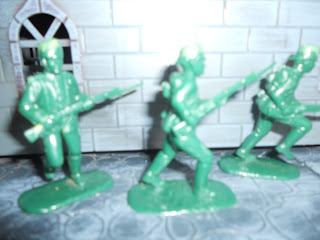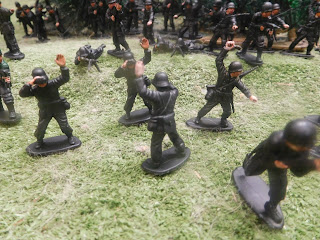The Fall Of A Fezian Frontier Castle
The siege of the Fezian frontier fort continued. The Patrans had withdrawn from their previous foothold on the battlements and positioned themselves around the castle. At next day's dawn they charged again. The Fezian archers lined the walls and caused some early casualties. Then the Patrans were against the walls and placing ladders.
The war elephant enters the castle.
The Blue Romans had trouble making headway on the Northern wall.
Greeks finally gain ground on the Western wall.
On the Southern wall the catapults halt their shooting and the Hillmen climb the ladders. The Fezians had left the wall lightly defended and moved troops up too late to stop the Hillmen gaining ground.
On the Eastern wall, too, despite fierce resistance from Fezian tribal levies, the Romans sweep the battlement.
Meanwhile, in the courtyard the Patran war elephants has pushed forward the wagons that the Fezians have placed at the gate entrance. Then units of Greek infantry, followed by Greek cavalry pour through the gap. The tribal lights flee the Greeks who, after reforming, charge them again and wipe them out.
Greek cavalry charge into the fort.
A line of Fezian matchlock men shoot at the Greek infantry but then they must deal with the Greek cavalry, these had already joined in the melee of the Fezian hero-commander and the lights against the elephant. the elephant eventually was killed by the matchlock men's firing and fell on a Greek cavalryman, flattening horse and rider. However, the Fezian's leader lay unconscious. They fought on for a while before surrendering.
The End of A Battle:
Perhaps if the Fezian garrison knew what was in stall for them they would have resisted longer but they had put up a good fight as a number of Patran infantry units were reduced to half strength.
below: The Hillmen were of mainly Viking origin and also some Celts. Usually they dressed in mail shirts or tunics. Some, however, fought bare chested or even naked, such was their battle frenzy. And some of them were Hillwomen! The Hill people society allowed some women to become warriors. Often their fathers were great warriors and often had lost or did not have sons.
Friga was one of these female banshees. Her mother was either a Celt or a Pict and her daughter followed the custom of covering herself in blue dye patterns. She also had the war fever in her blood. few men could stand against her. Today the Fezians on the South wall also came to know her smiting axe, Brainbiter.
So it happened, when Biggusdiccus called for executioners, Friga volunteered, her lover, Snoggi, had died on the battlement and her fury was not yet spent. below she can be seen with the head of one of her victims. But it was Biggusdiccus who was increasingly being called 'The Butcher' with his record for immediate killing of civilians. Only the Fezian leader was spared - for now.
A list of the surviving Fezians will be made in a future post.













































Comments
Post a Comment